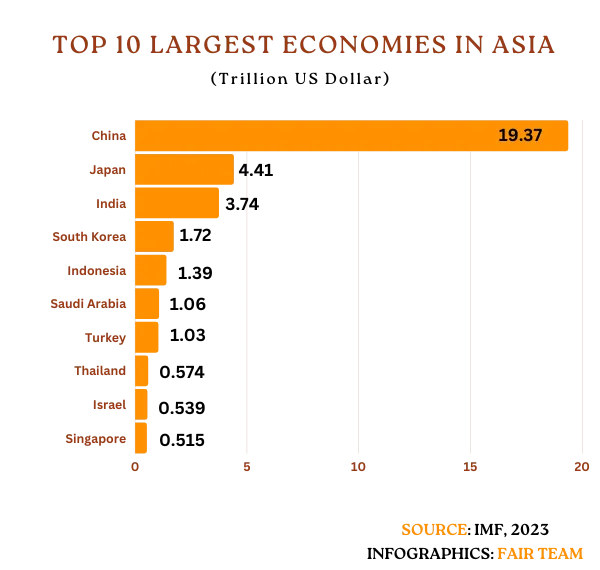Asia holds the distinction of being the largest continental economy globally, constituting a remarkable 60% of the world’s population. This diverse and dynamic continent has borne witness to several economic booms, including the Japanese economic miracle, the resounding growth in China and India, the awe-inspiring transformation along the Hun River in South Korea, and the emergence of the Tiger Cub economies. Additionally, Asia maintains its reputation as the fastest-growing economic region. This article will explore the economic prowess demonstrated by the top 10 largest economies in Asia, each of which plays a vital role in bolstering the region’s profound global significance.
List of the top 10 largest economies in Asia
The top 10 largest economies in Asia are China, Japan, India, South Korea, Indonesia, Saudi Arabia, Turkey, Thailand, Israel, and Singapore
China, the largest economy in Asia
China is the largest economy in Asia and the second-largest globally. It is often referred to as the “dragon economy”. Fueled by a potent combination of industrial might, technological innovation, and a vast consumer market, China’s economic landscape is a force to be reckoned with. Its journey from a predominantly agrarian society to a manufacturing and technological juggernaut has been nothing short of remarkable.
With a GDP of $19.37 trillion, China boasts a multifaceted economy encompassing manufacturing, technology, finance, and services. The nation’s strategic investments in research and development, as well as its push for emerging industries like artificial intelligence and renewable energy, solidify its role as a global economic powerhouse. As the dragon economy continues to evolve, its influence resonates across continents, shaping the trajectory of international trade and economic dynamics.
Japan
Japan’s economy stands as a beacon of technological prowess and innovation in Asia. With a GDP of $4.41 trillion, it secures its place as one of the continent’s economic powerhouses. Renowned for its precision engineering, electronics, and automotive industries, Japan has left an indelible mark on the global stage. The country’s economic journey is marked by the famous Japanese economic miracle, a remarkable post-war resurgence that propelled it to the forefront of economic development.
Embracing a culture of continuous improvement, Japan has remained a leader in robotics, advanced manufacturing, and high-tech consumer goods. Its commitment to research and development drives innovation in areas like semiconductor technology, biotechnology, and sustainable energy. Despite demographic challenges, Japan’s economic resilience, export-oriented approach, and dedication to excellence continue to shape its influential role in the global economy.
India
India’s economy, a vibrant tapestry of tradition and modernity, holds a pivotal position in Asia’s economic landscape. With a GDP of $3.74 trillion, it ranks among the largest economies on the continent. Known for its rich cultural heritage and diverse population, India has also emerged as a hub for information technology services, software development, and a burgeoning startup ecosystem. The country’s economic trajectory is marked by impressive growth rates and a growing middle class, driving consumer demand and investment opportunities.
As the world’s largest democracy, India’s policy reforms and liberalization have spurred economic expansion across sectors. It continues to attract global attention for its skilled workforce, making significant contributions to pharmaceuticals, software development, and engineering. With a blend of ancient wisdom and cutting-edge innovation, India’s economy embodies a unique blend of the past and the future, positioning it as a key player in shaping the economic landscape of Asia and beyond.
South Korea
South Korea’s economy, a dynamic blend of innovation and industrial prowess, takes center stage in Asia’s economic arena. With a GDP of $1.72 trillion, it wields considerable influence as a technological powerhouse. Known for its remarkable transformation from post-war devastation to a global leader in technology and manufacturing, South Korea’s journey is often referred to as the “miracle on the Hun River.”
The country’s success is fueled by giants like Samsung, LG, and Hyundai, which have established it as a world leader in electronics, automotive, and shipbuilding industries. Its commitment to research and development has also propelled it to the forefront of 5G technology, advanced materials, and semiconductor manufacturing. South Korea’s export-driven model, skilled workforce, and innovative culture contribute to its unwavering position as a trailblazer in the global economic landscape, forging a path of progress that continues to resonate across industries and continents.
Indonesia
Indonesia’s economy, a mosaic of natural resources and diverse industries, shines as a beacon of potential in Asia. With a GDP of $1.39 trillion, it holds a significant place among the continent’s economic players. Known for its vast archipelago, Indonesia’s rich natural resources have been pivotal to its economic growth. The nation’s journey reflects its strategic focus on infrastructure development and economic diversification.
With a large and youthful population, Indonesia boasts a growing middle class that fuels domestic consumption and entrepreneurial ventures. As a major agricultural producer and a leading exporter of commodities, Indonesia’s palm oil, mining, and textiles industries also play crucial roles. The nation’s commitment to sustainable development, coupled with investment in infrastructure and human capital, paints a picture of a nation poised to unlock its economic potential and assert itself as a formidable force in the global economic landscape.
Saudi Arabia
Saudi Arabia’s economy, synonymous with oil wealth, commands attention as a significant player in Asia’s economic theater. With a GDP of $1.06 trillion, it stands as a regional heavyweight. The nation’s historical reliance on oil has shaped its economic landscape. It is a key player in global energy markets. However, Saudi Arabia is charting a transformative path through its Vision 2030 initiative, which seeks to diversify the economy and reduce dependency on oil. This visionary approach aims to nurture sectors like tourism, entertainment, technology, and renewable energy, steering the nation toward a more sustainable and diversified future.
The strategic investments in mega-projects, such as NEOM, reflect Saudi Arabia’s aspirations to be a hub of innovation. As the nation reinvents itself, its economic evolution holds implications far beyond its borders, reshaping the perception of an oil-based economy and championing a new era of growth and modernization.
Turkey
Turkey’s economy, a bridge between continents and cultures, stands out prominently in Asia’s economic landscape. With a GDP of $1.03 trillion, it plays a significant role on the continent. Additionally, situated at the crossroads of Europe and Asia, Turkey’s strategic location has long been a conduit for trade and cultural exchange. The nation’s diverse economy encompasses industries ranging from textiles and automotive manufacturing to agriculture and tourism. Known for its rich history and modern urban centers, Turkey has attracted international attention for its dynamic approach to development.
As a member of the G20, Turkey’s economic policies have fostered growth and attracted foreign investment. Its youthful population and entrepreneurial spirit also contribute to a thriving startup ecosystem. By capitalizing on its geographical position, historical heritage, and economic reforms, Turkey continues to carve a distinct path, bridging its past with an innovative future that resonates both regionally and globally.
Thailand
Thailand’s economy, a gem of Southeast Asia, radiates significance within Asia’s economic panorama. With a GDP of $0.574 trillion, it stands as a notable force in the region. Known for its stunning landscapes, rich cultural heritage, and robust tourism industry, Thailand has built a diverse and resilient economy. From its agricultural exports to its flourishing manufacturing sector, the nation’s economic evolution has been marked by adaptability and innovation.
Thailand’s strategic location, coupled with its advanced infrastructure, has attracted foreign investment. It is also a key player in regional trade. The country’s tourism sector, renowned for its unique blend of ancient temples and modern resorts, is a vital economic pillar. As Thailand continues to invest in technology, renewable energy, and sustainable practices, it positions itself as a beacon of growth and adaptability, enriching not only its own economic fabric but also contributing to the wider dynamism of Asia’s economic landscape.
Israel
Israel’s economy, a hub of innovation and entrepreneurship, shines as a distinct presence in Asia’s economic fabric. With a GDP of $0.539 trillion, it holds a notable position within the continent. Despite its small size, Israel has earned the moniker “Startup Nation”. It has achieved remarkable technological advancements and rapid industrial development.
The nation’s expertise in fields like cybersecurity, biotechnology, and software development has garnered international acclaim. Its strong research institutions, coupled with a culture of creativity, have fueled breakthroughs in science and technology. Israel’s economic journey is marked by its ability to transform challenges into opportunities. It has developed a vibrant startup ecosystem and has a reputation for innovation that resonates worldwide. As the country continues to invest in research, development, and technology transfer, it shapes a trajectory of growth that solidifies its role as a key player in Asia’s dynamic economic panorama.
Singapore, the 10th largest economy in Asia
Singapore’s economy, a thriving financial and commercial nucleus, illuminates Asia’s economic landscape with distinction. With a GDP of $0.515 trillion, it holds a pivotal role within the continent. Despite its modest size, Singapore has evolved into a global economic powerhouse. Additionally, it is renowned for its business-friendly environment, strategic location, and efficient infrastructure. Singapore is also at the top of the list of the richest countries in Asia.
The nation’s status as a major financial center in Southeast Asia has attracted multinational corporations, financial institutions, and investment flows. Its emphasis on education, innovation, and research has positioned it as a leader in technology and biomedicine. Singapore’s commitment to sustainable development, coupled with its world-class connectivity and well-developed logistics, enables it to thrive as a trade hub. As the nation continues to adapt to changing global dynamics, its economic resilience, diverse industry portfolio, and strategic planning solidify its influential role, shaping Asia’s economic narrative and underscoring its status as a beacon of stability and prosperity.
Summary of the top 10 largest economies in Asia
- China: $19.37 Trillion
- Japan: $4.41 Trillion
- India: $3.74 Trillion
- South Korea: $1.72 Trillion
- Indonesia: $1.39 Trillion
- Saudi Arabia: $1.06 Trillion
- Turkey: $1.03 Trillion
- Thailand:$0.574 Trillion
- Israel:$0.539 Trillion
- Singapore: $0.515 Trillion
In conclusion, the top 10 largest economies in Asia embody the continent’s dynamism and diversity. From technological powerhouses to emerging giants, each country contributes uniquely to Asia’s economic tapestry. These nations continue to invest in innovation, infrastructure, and human capital. They will also shape the future not only of the continent but also of the global economy.








